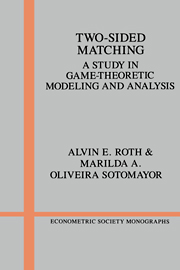Book contents
- Frontmatter
- Chapter 1 Introduction
- Part I One-to-one Matching: the Marriage Model
- Part II Many-to-one matching: models in which firms may employ many workers
- Part III Models of one-to-one matching with money as a continuous variable
- Chapter 7 A simple model of one seller and many buyers
- Chapter 8 The assignment game
- Chapter 9 A generalization of the assignment model
- Part IV Epilogue
- Bibliography
- Name Index
- Subject index
Chapter 7 - A simple model of one seller and many buyers
from Part III - Models of one-to-one matching with money as a continuous variable
Published online by Cambridge University Press: 05 January 2013
- Frontmatter
- Chapter 1 Introduction
- Part I One-to-one Matching: the Marriage Model
- Part II Many-to-one matching: models in which firms may employ many workers
- Part III Models of one-to-one matching with money as a continuous variable
- Chapter 7 A simple model of one seller and many buyers
- Chapter 8 The assignment game
- Chapter 9 A generalization of the assignment model
- Part IV Epilogue
- Bibliography
- Name Index
- Subject index
Summary
Consider a market consisting of a single seller, who owns one unit of an indivisible good, and n buyers, each of whom is interested in purchasing the object if the price is right. Each buyer b places a monetary value $rb on the object, which is the maximum amount he or she is willing to pay, and the seller similarly places a value $rs on the object, which is the price below which he or she will not sell. We call these monetary values the reservation prices of the agents. Each buyer has cash on hand sufficient to pay his or her reservation price.
We may interpret the reservation price as follows, for example. The seller has in hand an offer of $$rs from some outside party (not one of the buyers in the present market), who will buy the object at that price if it is offered by the seller. Each buyer (whom we may think of as a broker, rather than as a final consumer of the object) has in hand an offer of $rb from a client who will purchase the object from the buyer at that price, should he or she obtain it in the market. Since the seller knows that he or she can earn at least $rs, the seller will not sell at a lower price. And since each buyer b knows that he or she can earn $rb (but no more) by reselling the object, the buyer will not buy at a higher price.
- Type
- Chapter
- Information
- Two-Sided MatchingA Study in Game-Theoretic Modeling and Analysis, pp. 189 - 201Publisher: Cambridge University PressPrint publication year: 1990

